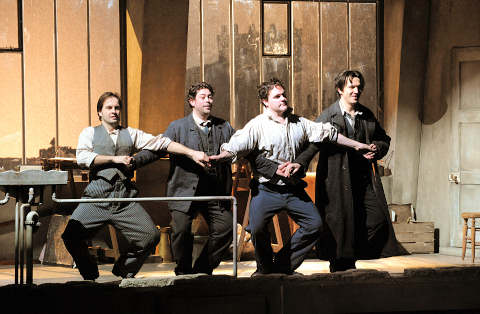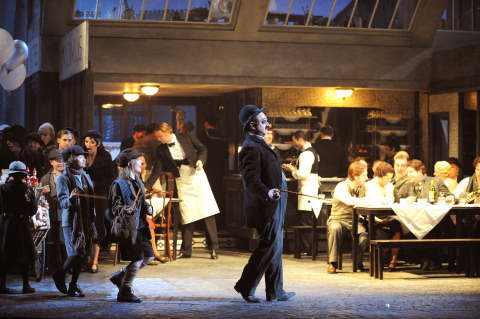Other Links
Editorial Board
-
Editor - Bill Kenny
-
Deputy Editor - Bob Briggs
Founder - Len Mullenger
Google Site Search
SEEN
AND HEARD UK OPERA REVIEW
Puccini, La bohème:
New production directed by Sir Jonathan Miller with
sets and costumes designed by Isabella Bywater.
Soloists, chorus and orchestra of the English
National Opera. Conductor: Miguel Harth-Bedoya. The
London Coliseum, 4.2.2009. (JPr)
In the publicity for these performances, these words
from Sir Jonathan Miller have often been repeated: ‘Puccini’s
operas are really rather like movies, and La bohème
is the most natural and believable of them all. I
want to make it as much like a movie as it could
possibly be. I’m basing the artists’ relationship on
the movie Withnail and I – shabby, upper class
boys who think squalor is very romantic.’ As
things worked out, Sir Jonathan may regret these
comments now because what we get is not seedy,
hedonistic or drug-fuelled enough to be associated
with this slice of life in late 1960’s
The Cafe Momus with Parpignol
In Act

The Bohemians' Garret
Miller, returning to the
ENO after his own gap of twelve years, and his
current regular designer, Isabella Bywater, strive
for cinematic realism by updating the action to Paris
in the early 1930s - coincidentally a period of
twentieth-century recession. That city’s
demi-monde was photographed by Cartier-Bresson,
Kertesz and Gyula Halász (alias Brassaï); photos by
the latter reprinted in the programme were clearly
the biggest inspiration to Bywater’s designs. There
are two solid split level revolving sets and the
flatmates appear to be living in a loft above the
Café Momus in a single room with (strangely) only one
bed. The room is connected to a bathroom and there
are stairs down to Mimi’s apartment. We can see the
comings and goings of Marcello, Colline, Schaunard,
Benoit, Mimì and Musetta but whether much is gained
from all this is less sure. Certainly what was lost,
was any great sense of drawing the audience into the
intimate world of the bohemians, The setting will
have made for good television - the first performance
was broadcast by Sky Arts - but will have made little
impact on those in the London Coliseum’s Upper Circle
or Balcony. The performing space containing little
more than a couple of desks, the bed, an armchair
and, of course, the stove in which to burn Rodolfo’s
manuscript, was too claustrophobic and much of the
action too far upstage.
For the Café Momus scene, there was also too much
going on in too small a space and I think those in
the stalls might have lost some of the action due to
the children, the marching band and Parpignol (Philip
Daggett) as Charlie Chaplin parading across the
footlights and blocking their view. In the Dress
Circle nothing was lost and I assume it was clearly
seen on TV once again. (It was.
Ed)

Period films and photographs are intrinsically
two-dimensional and that was my reaction to the
overall evening. Apart from a very few French signs
and adverts on stage, as well as, the moustaches of
the waiters in the café, never did I feel I was
really in Paris - I could have equally been in
Whitechapel and Soho of the 1930s. Undoubtedly
charity shops had been scoured for
cloche hats, berets, fur-trimmed coats and couture
dropped-waist dresses for the women and dark wool
overcoats, suits and flat caps for the men. All of
this was in a generally muted colour palette and
‘enhanced’ by the monochrome lighting of Jean Kalman
so it had the look of the depictions of the 1930s,
but I was never convinced about where we actually
were. A true Gallic setting needs a headier whiff of
garlic!
The principals basically seem to have been left to
themselves to act as naturally as possible. Jonathan
Miller demands the eschewing of grand operatic
gestures and his lack of theatricality drains the
energy from the proceedings - so much so that it
seemed more like the tenth revival of a familiar
production rather than the first night. Rodolfo is a
very insecure and far-from-romantic figure, ardent
yes, but possibly still a virgin. Mimì is probably
the experienced ‘older woman’ that most students
throughout history have craved. Even Musetta seems to
play up Rodolfo’s innocence by aiming more to
embarrass him with her song than trying to rekindle
Marcello’s passion. She is something of a Piaf-like
creation here and evidently quite a popular figure
based on the autographs she is asked to sign.
I couldn’t help but think that this was an
opportunity missed by the director and the
imagination that brought us his earlier ‘celebrated
classics’ (in ENO’s artistic director John Berry’s
words) seems to have been dulled by the passing
years. I would have liked something different to
engage the mind – perhaps it could have been set in
Paris during the German occupation : I wouldn’t wish
for an operatic version of ‘Allo, ‘Allo! of
course, but this setting might have reinvented
the story rather more to allow for more drama and to
engage the audience more fully in the idealism,
passions and fatalism of Puccini’s characters.
Perhaps Jonathan Miller wanted to leave the emotional
impact of the evening to Puccini’s music, but the
young Peruvian conductor, Miguel Harth-Bedoya, drew a
rather cool account from his extremely competent
orchestra. There were some subtle orchestral details
and colours yet his tempi were rather elastic and the
dynamics varied little whether the quieter or louder
singers were involved. I was left with the feeling
that he was accompanying the performance rather than
driving it forward.
Amanda Holden’s new English translation was competent
and in a familiar rhyming couplet style - ‘Mimì go
home then, go on your way, you’d be unwise to stay’ -
with some anachronisms and use of vernacular. The
singers concentrated on the vowel sounds and some
were more able to bring the words across than others
– the two women principals to be truthful, generally
had the louder voices and had the best diction. The
chorus and the children were excellent in their brief
appearance and Simon Butteriss as the landlord,
Benoit, and the veteran Richard Angas as Musetta’s
cuckolded companion, Alcindoro, were
well-characterized, but the roles of Marcello
(Roland Wood), Colline (Paul Putninš) and Schaunard
(David Stout) seemed underdeveloped and were somewhat
undersung.
As Rodolfo, Alfie Boe has an essentially small
lyrical voice and the London Coliseum is a daunting
space to fill with sound. Again, only the two
Americans, Hanan Alattar as the quintessential ‘tart
with a heart’ Musetta, and the delightfully named
Melody Moore, who excelled as Mimì, were capable of
that. Ms Moore making her European debut is the star
of the evening; her round rich dark toned soprano had
the elegant phrasing and very strong top notes of the
best Mimìs. She was impassioned in her Act III duet
with Marcello and suitably affecting at her death.
Surprisingly Dr Miller for all his medical
background, fails to give her a realistic demise
although I am sure he would argue otherwise. Even so,
she never seems frail or consumptive enough for such
an early death and barely coughs more than a few
times throughout the evening. If it wasn’t for the
great sigh heard from the orchestra, she could
easily have fallen asleep in the armchair and not
passed away. Alfie Boe’s best moments came right at
this point with his agonized realization that his
loved one had died and that he was the last to know.
This moment of high drama highlighted what the rest
of evening was truly lacking.
Jim Pritchard
Pictures © Tristram Kenton
Back
to Top
Cumulative Index Page
